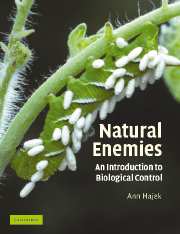Book contents
- Frontmatter
- Contents
- Preface
- Acknowledgments
- Introduction
- PART I Strategies for using natural enemies
- Chapter 3 Classical biological control
- Chapter 4 Augmentation: inundative and inoculative biological control
- Chapter 5 Conservation and enhancement of natural enemies
- PART II Biological control of invertebrate and vertebrate pests
- PART III Biological control of weeds
- PART IV Biological control of plant pathogens and plant parasitic nematodes
- PART V Biological control: concerns, changes, and challenges
- Glossary
- References
- Index
Chapter 5 - Conservation and enhancement of natural enemies
Published online by Cambridge University Press: 05 June 2012
- Frontmatter
- Contents
- Preface
- Acknowledgments
- Introduction
- PART I Strategies for using natural enemies
- Chapter 3 Classical biological control
- Chapter 4 Augmentation: inundative and inoculative biological control
- Chapter 5 Conservation and enhancement of natural enemies
- PART II Biological control of invertebrate and vertebrate pests
- PART III Biological control of weeds
- PART IV Biological control of plant pathogens and plant parasitic nematodes
- PART V Biological control: concerns, changes, and challenges
- Glossary
- References
- Index
Summary
This strategy for biological control differs from classical biological control and augmentation because natural enemies are not released. Instead, the resident populations of natural enemies are conserved or enhanced. There is a level of debate in the biological control community regarding what to call this strategy or even how to define it. Here, we use the definition of conservation biological control supported by DeBach (1964b), Barbosa (1998), and Eilenberg et al. (2001).
Modification of the environment or existing practices to protect and enhance specific natural enemies or other organisms to reduce the effect of pests
In fact, this strategy was first principally developed to conserve natural enemies that were being decimated through use of synthetic chemical insecticides (van den Bosch & Telford, 1964). Conserving natural enemies only later began to be linked with enhancing them. For many years, our knowledge of how to conserve and enhance natural enemies grew only haltingly. These are more passive approaches and are usually directed toward long-term control of pests. Conservation methods are usually not suitable for control of pests in high value crops that can withstand little damage (have a low economic injury level). A fundamental requirement for using conservation and enhancement is that the biology, behavior, and ecology of the pest and natural enemies must be understood to some extent. To develop effective conservation and enhancement of natural enemies we need to understand what factors are depressing natural enemy populations or otherwise inhibiting their ability to control pests, and these detractors must be alleviated.
- Type
- Chapter
- Information
- Natural EnemiesAn Introduction to Biological Control, pp. 80 - 96Publisher: Cambridge University PressPrint publication year: 2004



